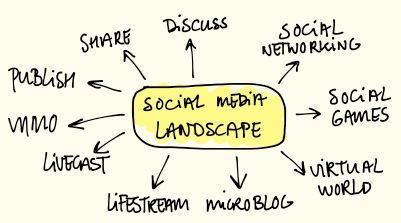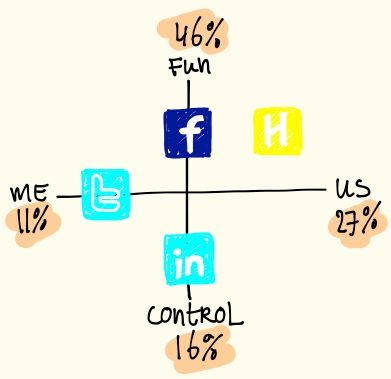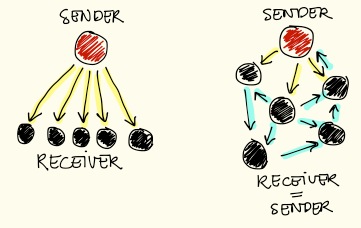Social media is here to stay and sports and exercise medicine is not immune. Do you happen to know at what time of the day 50% of all Facebook users check their Facebook page? You will find the answer (which will strike you) at the bottom of this blog. A load of other fun trivia is encapsulated in this YouTube video.
This video shows some fun facts about the spread of social media, and also its power. A power we can most definitely use in our work as sports medicine professionals but haven’t yet grasped in full.
Here I introduce the concept of social media, explain why social media is so powerful, and discuss some opportunities and challenges. Future blogs will delve deeper into specific topics.
What is social media?
Social media refers to the means of interactions among people in which they create, share, and exchange information and ideas in virtual communities and networks [1]. You probably know and use a fair share of different social media, e.g. Twitter, Facebook, LinkedIn, ResearchGate, Wikipedia, YouTube, Skype, Flickr, WordPress, MSN, etc. There are many, many more examples within the Social Media landscape which provides a divers palette of various social platforms.

Why is social media so powerful?
We can discern three types of media. In the center there is owned media. This can be a company website, a sports medical practice, a book, a health enhancing program, etc. It is the medium we want to draw attention to, a product we want to sell. We can draw attention through paid media; publicity gained through advertising or incentives. This will certainly attract a crowd but we need to reach each individual of our target population ourselves. Earned media refers to publicity gained through grassroots actions and provides a more efficient way to reach your target population.
 As an example, you may have developed an iPhone App around a training program to prevent injuries. You want to bring this under the attention of athletes so they can download the App and reduce their injury risk. You post the release of this App on Facebook together with some attractive screenshots and a short positive statement by – preferably – a well known athlete. Your followers see this and they “like” your Facebook post. Imagine you get a 100 likes. Each of your followers’ 100 friends will then see they liked your message, and in an instant you have brought your App under the attention of 10,000 individuals. This number will exponentially increase if these friends will also start to like your post, etc. The latter is called a viral, a marketeer’s favorite tool as it draws a huge amount of attention to a campaign with minimal effort. In addition, earned media is based upon recommendation by peers. Peer beliefs are a much stronger influencer than statements being made in advertisements.
As an example, you may have developed an iPhone App around a training program to prevent injuries. You want to bring this under the attention of athletes so they can download the App and reduce their injury risk. You post the release of this App on Facebook together with some attractive screenshots and a short positive statement by – preferably – a well known athlete. Your followers see this and they “like” your Facebook post. Imagine you get a 100 likes. Each of your followers’ 100 friends will then see they liked your message, and in an instant you have brought your App under the attention of 10,000 individuals. This number will exponentially increase if these friends will also start to like your post, etc. The latter is called a viral, a marketeer’s favorite tool as it draws a huge amount of attention to a campaign with minimal effort. In addition, earned media is based upon recommendation by peers. Peer beliefs are a much stronger influencer than statements being made in advertisements.
All marketing talk … how can we use Social Media?
Social media is a powerful marketing tool as it draws upon social networks. There are more uses of these networks than simply getting your word out into the world. Social media provides an information channel, a service platform, a tool to scope opinions of your peers, a crowdsourcing tool, and much more. Besides, in a sense we sports medicine professionals are selling a product as well. Whether you are a professional society like BASEM, an individual sports physician or physical therapist, a researcher, a lecturer … we all have a product to sell. You may want to check out how Sports Medicine Australia (SMA) has embraced social media to reach out to their peers.
@SMACEO
http://www.facebook.com/sportsmedicineaustralia)
I myself am a researcher (primarily) studying interventions to prevent injury. In the literature there are ample interventions that have been proven effective in controlled conditions. Yet, the translation of these effective preventive methods to the field is lagging behind. I see a massive opportunity to market these effective measures through social media and actually start preventing injuries in the field. A similar approach has made its way to interventions that promote physical activity. Initial results are very promising showing stronger and longer lasting intervention effects when offered through social networks [2-3]. I believe we have only peaked behind the curtain of possibilities.
Challenges in using social media
 Of course there are many challenges in using social media. Too many to discuss here and now, but it it should be stressed that individuals engage in a variety of social media platforms for different reasons. We can divide platforms in individual driven (me shouting out into the world) like Twitter, or group driven (let’s discuss stuff together) like the Dutch Hyves platform. Then platforms may be used for leisure / fun like Facebook, or have a more serious background like LinkedIn. When social media for our purposes we need to carefully think of where our target population is and why they are there.
Of course there are many challenges in using social media. Too many to discuss here and now, but it it should be stressed that individuals engage in a variety of social media platforms for different reasons. We can divide platforms in individual driven (me shouting out into the world) like Twitter, or group driven (let’s discuss stuff together) like the Dutch Hyves platform. Then platforms may be used for leisure / fun like Facebook, or have a more serious background like LinkedIn. When social media for our purposes we need to carefully think of where our target population is and why they are there.
Another challenge I would like to bring to the forefront here is in the evaluation of interventions administered through social media. The keyword in Social Media is interaction. Traditionally we are used to push out an intervention to individuals. Evaluation of the effect of an intervention on (intermediary) outcomes has been relatively simple as we know who the receivers of our intervention are and we are in direct contact with them. Though social media this all becomes more diffuse. We rely for the spread and success of an intervention on the interaction between receivers. This is much more difficult to control and measure and requires a different view on design, methodology and analysis of intervention outcomes.

To conclude
As said in the beginning of this blog the entire scope of social media is too large to grasp in a single blog. I aimed to introduce the topic and get you up to par with the concept of social media. Future blogs will delve deeper into the topic. Also you should take note that next year’s IOC World Conference on Prevention in Injury and Illness in Sport, will host a dedicated session on social media, as well as a keynote on the broader topic of eHealth for athlete care.
In the meantime, let’s see if we can grasp some of the benefits of social media here as well … I invite you to discuss the content of this blog below.
Answer: 48% of all Facebook users check their account in the morning, before using the toilet.
References
[1] Ahlqvist, Toni; Bäck, A., Halonen, M., Heinonen, S (2008). “Social media roadmaps exploring the futures triggered by social media”. VTT Tiedotteita – Valtion Teknillinen Tutkimuskeskus (2454): 13.
[2] Bickmore T, Gruber A, Picard R. Establishing the computer-patient working alliance in automated health behavior change interventions. Patient Educ Couns. 2005 Oct;59(1):21–30.
[3] Hekler EB, Gardner CD, Robinson TN. Effects of a college course about food and society on students’ eating behaviors. Am J Prev Med. 2010 May;38(5):543–7.
Author
Evert Verhagen @EvertVerghagen
Dept of Public and Occupational Health
VU University Medical Center
Amsterdam, NL
@evertverhagen
http://www.facebook.com/evert.verhagen